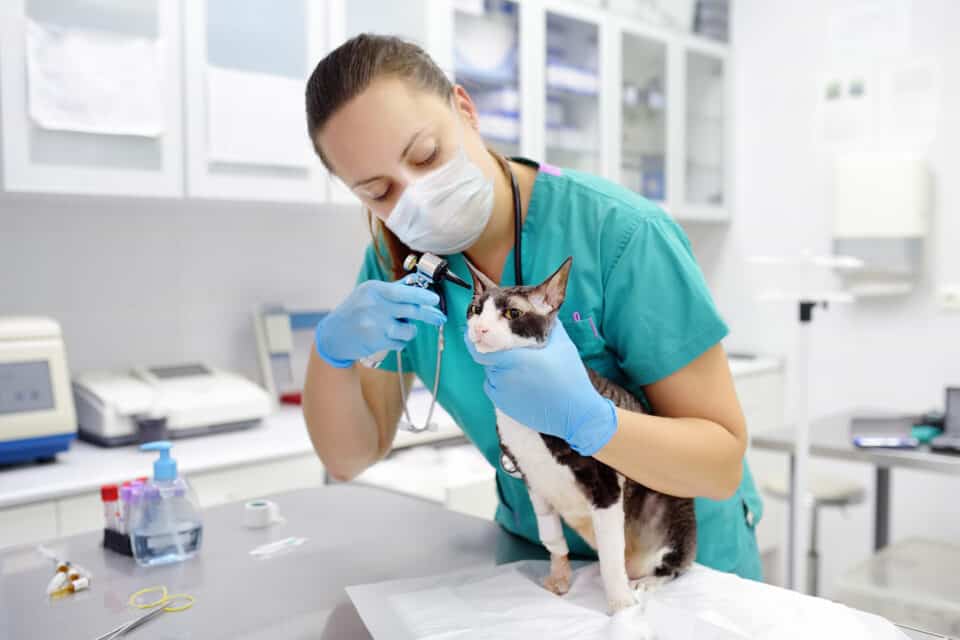A vet receptionist plays a vital role in veterinary practices by managing appointments, greeting clients, and assisting veterinary staff. This article will delve into their everyday responsibilities, necessary skills, and career opportunities.
Key Takeaways
- Veterinary receptionists are essential for managing the day-to-day running of a vet practice, including scheduling appointments, handling enquiries, and maintaining accurate client records.
- Strong communication skills and a basic understanding of pet healthcare are crucial for veterinary receptionists to effectively educate clients and ensure a positive experience.
- Career advancement opportunities exist for veterinary receptionists through continuous professional development in areas such as client care leadership, practice administration and management roles.
Key Responsibilities of Veterinary Receptionists
The daily life of a veterinary receptionist is a whirlwind of activity, requiring exceptional multitasking skills and a passion for both animals and people. From the moment they step into the practice, they set the tone for the day ahead.
Veterinary receptionists wear many hats in their role, from administrative duties to client support and financial transactions. Their responsibilities are vital to the efficient running of the veterinary practice.
Their responsibilities can be grouped into a number of key areas.
Morning Routine: Checking Messages and Setting Up
The morning for a veterinary receptionist typically begins with checking email and phone messages, ensuring no important communication is missed.
After addressing any pressing messages, they move on to setting up the reception and waiting area, making sure everything is clean, tidy, and ready to welcome patients and their owners. Knowing the day’s appointments helps create a positive impression on clients as they arrive.
Welcoming Clients and Pets
As clients and their pets arrive, the receptionist is the first point of contact, offering a warm welcome. They tailor their approach based on the pet’s condition, from providing comfort at difficult times, to sharing in the excitement of a new puppy or kitten. Every patient and their owner should feel important and valuable to the practice.
Once the initial greetings are done, the receptionist completes preliminary administrative tasks, including confirming the client and pet’s details are up to date and adding the pet to the waiting list so the clinical team know they have arrived. They may also help prepare the pet for the vet or nurse. A seamless transition from the reception area to the consultation room ensures that clients feel cared for and that their pets are in good hands.
Managing Appointments and Walk-ins
Managing appointments and walk-ins is a key responsibility for veterinary receptionists. They are responsible for scheduling appointments while also attending to clients who walk in without prior appointments, including emergencies. This ability to manage client flow is crucial for prioritising care and ensuring that vets and nurses can focus on clinical decision-making and patient care.
Efficient management of all types of visits – whether scheduled or unexpected – ensures timely care for patients and great service for clients. While some walk-ins involve pets needing urgent attention, other reasons include collecting food orders, prescriptions, or seeking advice, all of which require receptionists to give each client their full attention to keep things running smoothly.
Multitasking at the Reception Desk
At times the reception desk is the busiest place in the practice. Whether answering the phone, greeting clients when they arrive, or alerting the clinical team to a potential emergency, the ability to multitask is a useful skill to have.
Maintaining accurate client records and ensuring all documentation is up to date after each appointment is also important. A meticulous attention to detail and the ability to juggle multiple tasks efficiently is what keeps the practice running smoothly.
Handling Payments and Financial Transactions
That same attention to detail extends to handling payments and managing invoices. Whether it’s taking payment after a consultation or processing insurance claims, receptionists help ensure everything is accurate and professionally handled. At times this can be challenging, especially when pets are very unwell and approaching these conversations with empathy is essential.
Specialist Knowledge Required for Vet Receptionists
Veterinary receptionists may choose to further their knowledge in particular areas, helping them carry out their day-to-day tasks with confidence.
Understanding Pet Healthcare Plans
Many practices offer pet healthcare plans, covering routine preventive health, including vaccinations and parasite control. Receptionists can help educate pet owners about preventive care, and the benefits of these plans – namely health benefits for pets and a convenient way of spreading veterinary costs for owners.
Basic Parasitology and Nutrition Advice
A basic understanding of parasitology and nutrition enables receptionists to offer advice where appropriate. They can also educate clients on other aspects of pet health, including vaccinations, microchipping, neutering, and the importance of regular check-ups.
Dental Care and Behaviour Tips
Educating pet owners on the importance of dental care is another area where receptionists can support pet health. Having knowledge of the dental care products available in the practice is useful as well as an understanding of the importance of regular dental check-ups and treatment in preventing serious health issues. In summary, a regular dental care routine is vital for pets’ overall health.
Another area where owners may ask for support, is to help manage pets with behaviour problems. In most cases, these pets should have a check up with a member of the clinical veterinary team first to rule out medical problems. In some cases, referral to a pet behaviourist will be required.
Qualifications and Training for Aspiring Vet Receptionists
To excel, the aspiring veterinary receptionist should acquire relevant qualifications and training. Gaining experience and engaging in continuous professional development is essential, even if specific academic entry requirements are not stringent.
Relevant Courses and Certifications
The Level 3 Certificate in Veterinary Reception Skills is a well-regarded qualification that equips veterinary receptionists with the knowledge and confidence to start – and grow – a career in veterinary practice.
Building on this, gaining experience and taking additional training in areas such as leadership and customer service can open the door to more senior roles and greater responsibilities within the team.
Continuous Professional Development
Continuous professional development keeps veterinary receptionists’ skills relevant and up to date. Leadership skills, management, client communication and even topics like emergency support or basic animal behaviour, can further enhance expertise.
Agilio iLearn is the ultimate CPD platform built specifically to support your career as a veterinary receptionist. Accessible anytime, anywhere, it’s designed to seamlessly fit into your busy schedule while delivering training that meets your individual needs.
Career Progression and Opportunities
There are numerous opportunities for career progression. With the right combination of experience, initiative and training, receptionists can progress into more senior roles, take on new responsibilities, or specialise in areas that match their interests or expertise.
Moving into Supervisory or Managerial Roles
Demonstrating leadership and pursuing relevant training can help veterinary receptionists move into head receptionist or practice manager roles.
Frequently Asked Questions
How do you become a vet receptionist in the UK?
To become a vet receptionist in the UK, you should complete the BVRA Foundation and Intermediate courses, which provide essential qualifications and skills for the role. This training will equip you with the knowledge needed to succeed in a veterinary reception position.
What are the main responsibilities of a veterinary receptionist?
The main responsibilities of a veterinary receptionist include managing appointments, handling administrative tasks, providing client support, and processing financial transactions. These tasks are crucial for the smooth operation of the veterinary practice.
What qualifications are needed to become a veterinary receptionist?
To become a veterinary receptionist, pursuing relevant courses like the Level 3 Veterinary Receptionist Certificate can enhance your qualifications, although there are no mandatory academic requirements. Continuous professional development in the field is also highly beneficial.
How do veterinary receptionists support veterinary teams?
Veterinary receptionists support veterinary teams by managing enquiries, coordinating appointments, and keeping patient records organised. This enables the clinical staff to concentrate on providing quality care and facilitates effective clinic operations.
What specialist knowledge is required for a veterinary receptionist?
It is helpful for a veterinary receptionist to have a solid understanding of pet healthcare plans, basic parasitology, nutrition, dental care, and even basic animal behaviour. Some of this training will be provided by the veterinary practice but additional training, through CPD courses can be helpful to ensure receptionists can handle enquiries with confidence.
Summary
In summary, veterinary receptionists are a vital part of the veterinary practice team, combining admin skills, client support, and adaptability to keep things running smoothly. Aspiring veterinary receptionists should focus on gaining relevant qualifications, experience, and continuous professional development to excel in this rewarding career.


